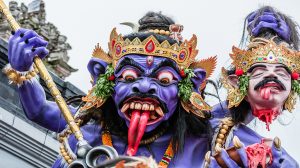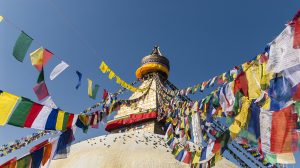New Year’s isn’t always fireworks and kisses. In Asia, it’s a time to ward off bad luck, celebrate good fortune, and commemorate family.
And since most of these countries follow the lunar or solar calendar, their festivities take place in February, March, or April, instead of on January 1st. Some cultures usher in the New Year with water gun fights, while others chase off evil spirits with demonic effigies.
Intrigued? We’ve got you covered. See how these six Asian countries ring in the New Year.
Chinese New Year (Spring Festival)
When: February 16th

According to legend, Chinese New Year started with the fight against a mythical beast called “Nian” — a bull and lion-like creature that appeared in China on New Year’s Eve. Learning that the monster feared fire, loud noises, and the color red, the villagers covered their houses in red and lit firecrackers to scare him off.
People still honor the origin story, hanging red lanterns and parading through the streets as dragons and lions. Afterward, they feast on celebratory dishes like longevity noodles, which symbolize a long life, and give children red envelopes (hongbao) stuffed with money to encourage good fortune in the New Year.
Korean New Year (Seollal)
When: February 16th

Koreans commemorate the first day of the lunar year by donning their hanbok (traditional clothing) and gathering for charye, a ritual prayer to their ancestors for peace and good health. Eating the eumbok (ritual food) passes their ancestor’s hopes and blessings on to them.
After the meal, younger generations pay respect to the elderly with a sebae (bow) in exchange for sebaedon (New Year’s money).
Thai New Year (Songkran)
When: April 13th – April 15th

Derived from the Sanskrit word meaning to pass and move into, Songkran signals the beginning of a new solar year. The first day of celebration transforms Thailand into a giant water fight. But it’s not just fun and games: Thais believe that water washes away bad luck, so throwing it is actually a sign of respect and well-wishing.
On the 14th, also known as Family Day, people spend time at home with their loved ones. Lastly, on the third day of Songkran, Thais visit wats (Buddhist monasteries) to ask for forgiveness and give alms.
Balinese New Year (Nyepi)
When: March 17th

In the days preceding the Hindu New Year, Balinese worshippers parade through the streets with demonic effigies (ogah-ogahs) and whip one another with fiery coconut husks to chase away evil spirits.
When the day of Nyepi arrives, the whole country shuts down. The government forbids lights, cars, and work, and the citizens spend the day in silence to focus on self-reflection. Some believe this quiet tricks the spirits into thinking everyone has left the island, in hopes that the demons will, too.
Tibetan New Year (Losar Festival)
When: February 16th – February 18th

On Losar Eve, Tibetans prepare a special dumpling soup, guthuk, with symbolic ingredients like chilies, rice, and coal. Once they get their fill, they run around their villages with firecrackers and straw torches to scare off ghosts and demons.
Families wake up early on Losar to place animal offerings for the gods in their household shrines. They also hang new multi-colored prayer flags to promote peace, compassion, and wisdom. When the wind blows, it carries their messages with it.
Vietnamese New Year (Tet)
When: February 16th

Because the Chinese brought the Lunar New Year to Vietnam, Tet celebrations also revolve around family and reunions. This means welcoming far-flung relatives and the spirits of deceased ancestors for a dinner of traditional food like bánh chung, a rice cake stuffed with beans and pork, and mang, a bamboo shoot soup.
They also buy flowering peach trees to fill their homes with life and good fortune.
While many Asian traditions involve gifting money, not everyone can hop on a plane to partake. If you’re celebrating from afar, keep up with the customs by sending money to your loved ones online.





